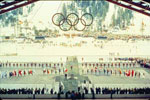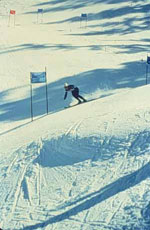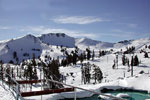 |
||
 |
 |
|
![]()
|
History of Squaw Valley, California The History of Squaw Valley USA In 1946, Squaw Valley worked its magic on a young man named Alexander Cushing, who had traveled with friends to the Sierra Nevada on a four day train ride from the East Coast. Cushing, then a lawyer on Wall Street, had served in the Navy and was ready for a change. On his first day skiing at Sugar Bowl, Cushing did the “unmentionable” and broke his ankle. While there, he heard a young man named Wayne Poulsen speak of a nearby place with the best skiing in the country. Intrigued by Poulsen’s statement, Cushing asked to see this place, and soon found himself on crutches, watching from the meadow while his friends hiked and schussed the glorious peaks of Squaw Valley. On November 24, 1949, less than three years after his first visit, Cushing opened the Squaw Valley Development Company. Skiers could ride the world’s largest double chairlift, Squaw One, and a choice of two rope tows, including one known as “Little KT.” At day’s end, an unfinished Squaw Valley Lodge offered respite for those too weary to brave the rough-hewn roads. Just prior to opening day, at Cushing’s request, Pascal “Pete” Heuga joined the Squaw Valley family selling lift tickets, working lift lines, and cutting trails. Heuga recalls “there was always something to do.” During the 1960 Olympics, he oversaw operation of the ice arenas. In 1968 Heuga, whose son Jimmie won a silver medal in the 1964 Olympics, retired from Squaw Valley USA, only to return several days later to run the tram for 17 more years. A notoriously strict ticket checker, Pete Heuga’s presence was known all over the mountain, and his smile continues to be a familiar sight in the valley today. Four days after the grand opening, a flood closed the resort’s doors. In what would become typical fashion for the company, Cushing and his close-knit crew worked 17 and 18 hours each day to reopen in time for Christmas. Squaw Valley’s spirit has been tested more than once. Squaw One was destroyed by avalanche each year for its first three years. The fourth year of operations there was a devastating flood, and during the fifth year, the lodge burned down. For many, these setbacks would have signalled the time to sell out; instead, Alex surprised millions by securing Squaw Valley as the site for the 1960 VIII Olympic Winter Games, beating out internationally regarded resorts such as Innsbruck, Austria, St. Moritz, Switzerland and Garmisch-Partenkirschen, Germany. The Olympics brought Lake Tahoe international publicity and sparked interest in winter sports and California skiing. • Alaska • Arizona • California • Colorado • Idaho • Montana • |
||||||||||||||||||||

1960 Olympics Opening |

1960 Olympics |

1960 Olympics Race |

Upper Bliss |
Email us at info@pacificrimalliance.org
Contents of this site Copyright © 1997-2019 by Pacific Rim Alliance. All rights reserved.
Site designed & maintained by Graphic Dezignz. Last updated October 17, 2017.
 |
 |
Skiing is a Dance in which the Mountain always Leads
